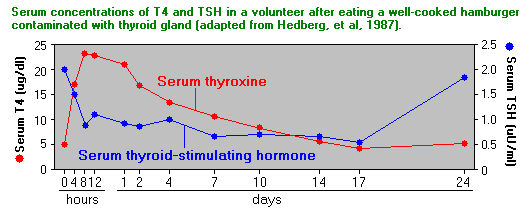VIVO Pathophysiology
Hamburger Thyrotoxicosis
 Thyroid hormones are orally active, which means that consumption of thyroid gland tissue can cause thyrotoxicosis, a type of hyperthyroidism. Several outbreaks of thyrotoxicosis have been attributed to a practice, now banned in the US, called "gullet trimming", where meat in the neck region of slaughtered animals is ground into hamburger. Because thyroid glands are reddish in color and located in the neck, it's not unusual for gullet trimmers to get thyroid glands into hamburger or sausage. People, and presumably pets, that eat such hamburger can get dose of thyroid hormone sufficient to induce disease.
Thyroid hormones are orally active, which means that consumption of thyroid gland tissue can cause thyrotoxicosis, a type of hyperthyroidism. Several outbreaks of thyrotoxicosis have been attributed to a practice, now banned in the US, called "gullet trimming", where meat in the neck region of slaughtered animals is ground into hamburger. Because thyroid glands are reddish in color and located in the neck, it's not unusual for gullet trimmers to get thyroid glands into hamburger or sausage. People, and presumably pets, that eat such hamburger can get dose of thyroid hormone sufficient to induce disease.
A report by Hedberg and colleagues (1987) on this topic is one of several in the literature. They described an outbreak of thyrotoxicosis in Minnesota and South Dakota that was traced to thyroid-contaminated hamburger. A total of 121 cases were identified in nine counties, with the highest incidence in the county having the offending slaughter plant. The patients complained of sleeplessness, nervousness, headache, fatique, excessive sweating and weight loss.
The graph below shows serum concentrations of thyroxine and thyroid-stimulating hormone in a volunteer that consumed a well-cooked, 227 g hamburger (admittedly, a large meal) prepared from the contaminated meat. Note how TSH levels were suppressed during the time when thyroxine (T4) concentrations were elevated.

Humans are not the only animals that experience this disorder. There have been periodic recalls of canned dog food because dogs that consumed them become ill, associated with elevated levels of bovine thyroid hormones in the food.
References and Reviews
- Hedberg CW, Fishbein DB, Janssen RS, et al: An outbreak of thyrotoxicosis caused by the consumption of bovine thyroid gland in ground beef. New Eng J Med 316:993, 1987.
Send comments to Richard.Bowen@colostate.edu
